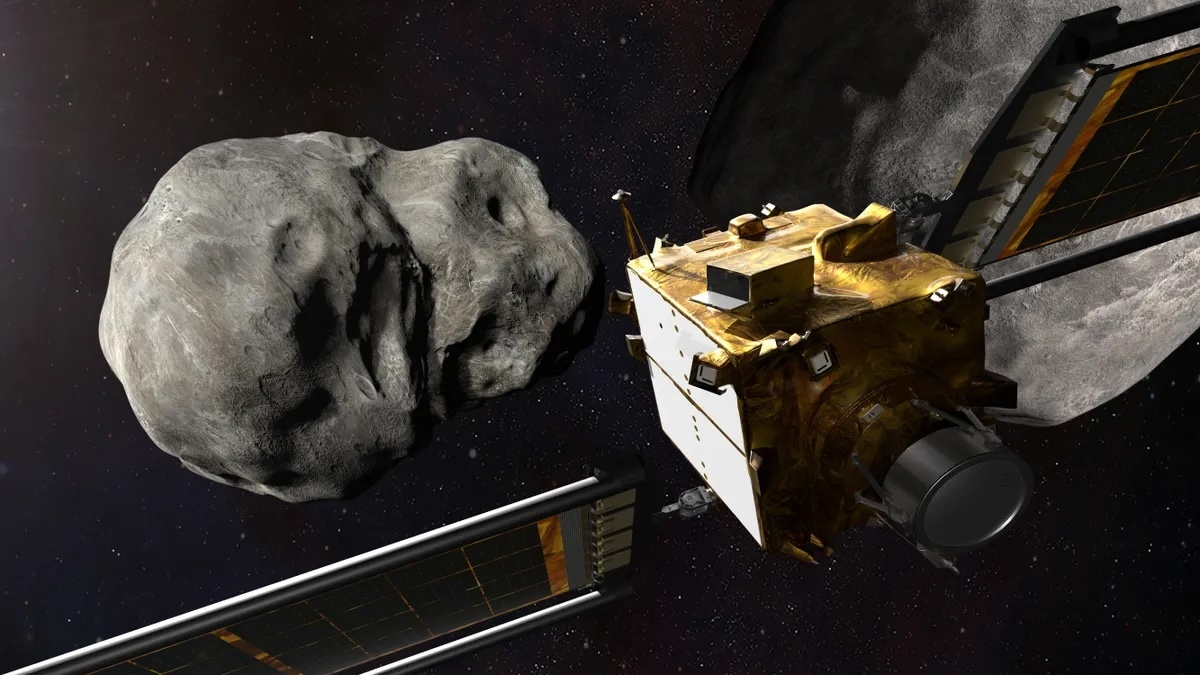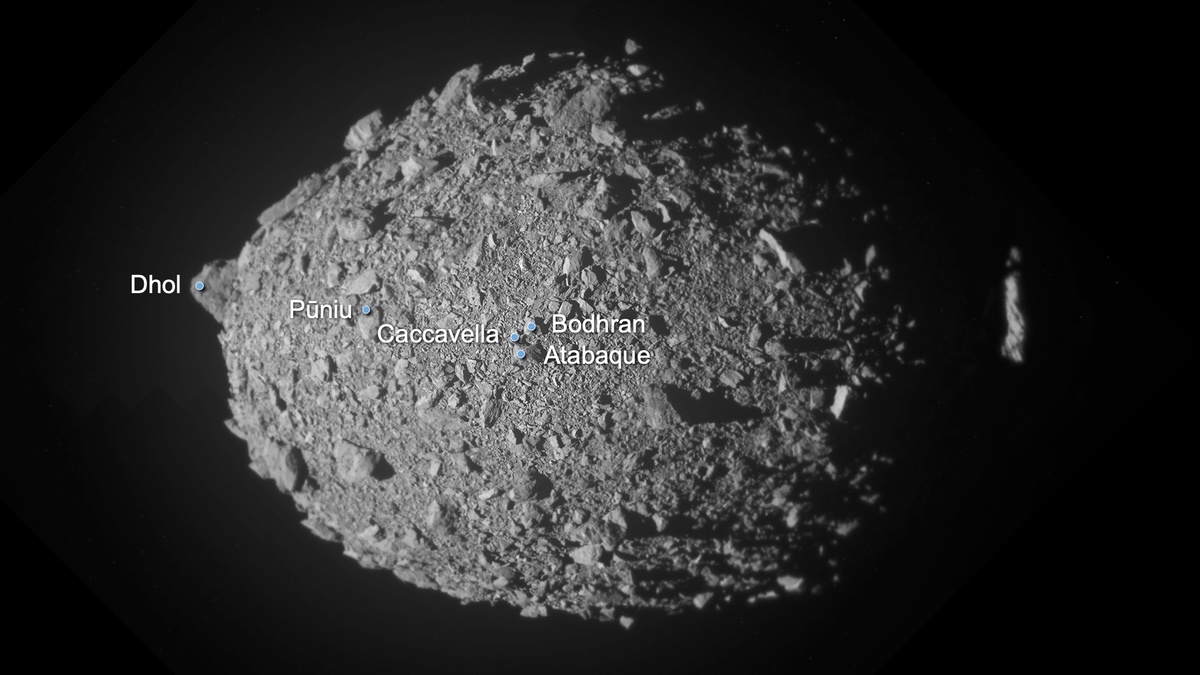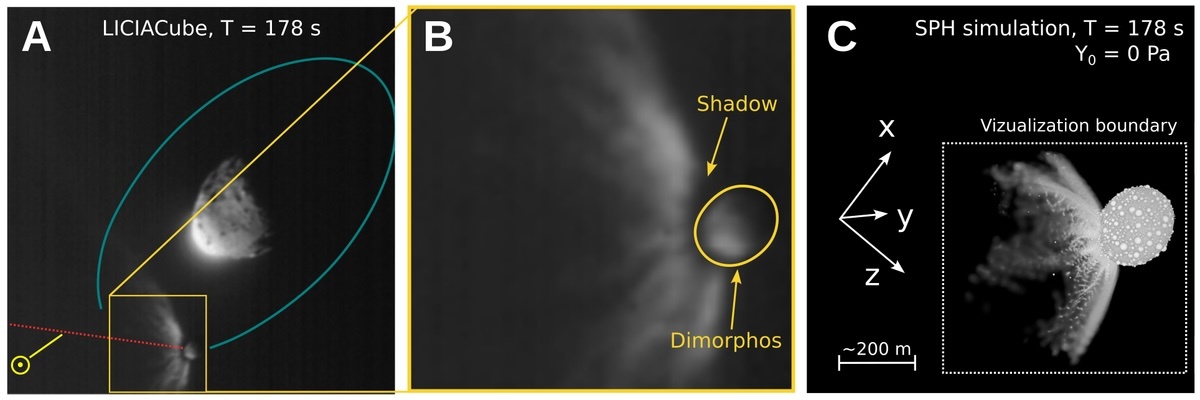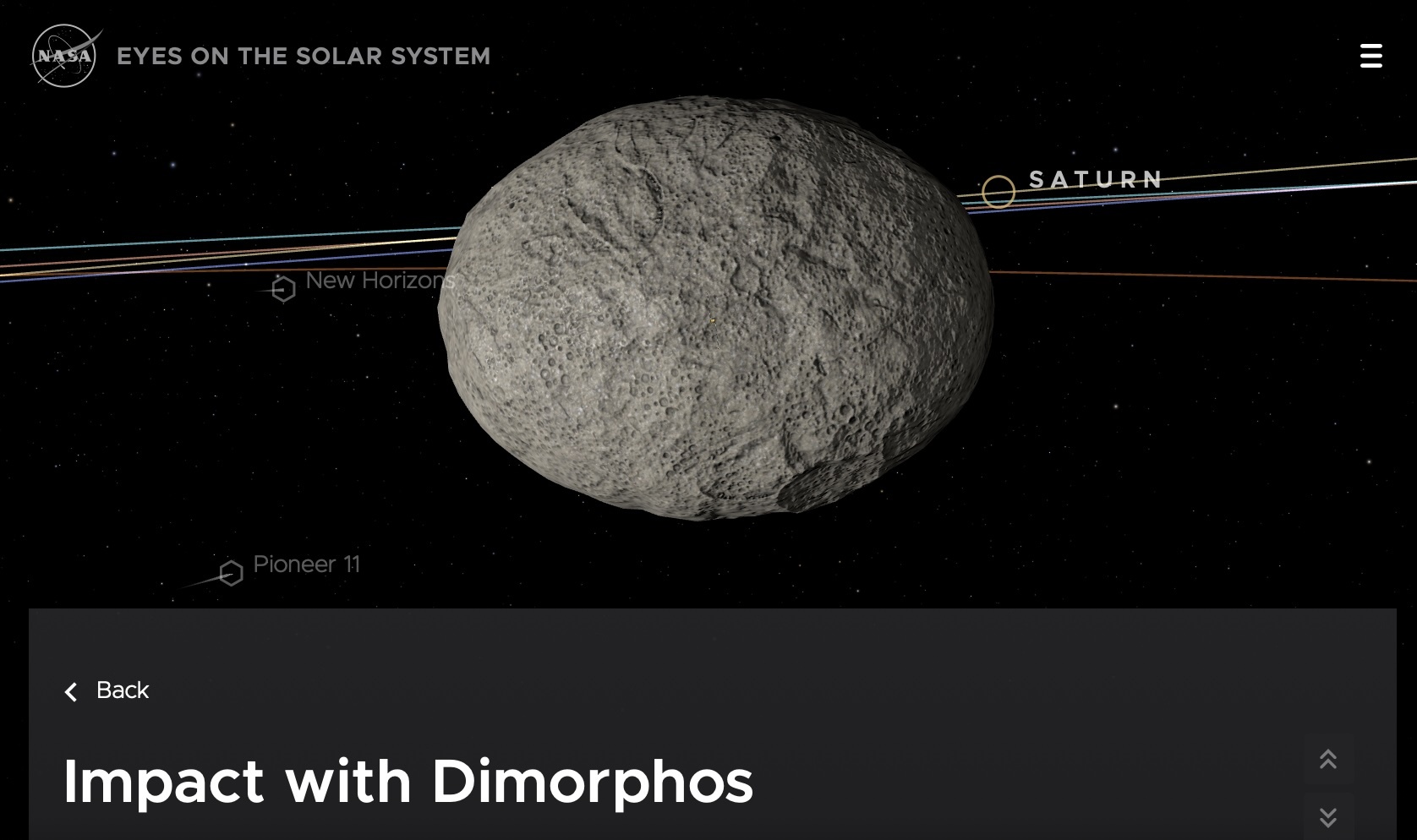In studying data collected from NASA’s DART (Double Asteroid Redirection Test) mission, which in 2022 sent a spacecraft to intentionally collide with the asteroid moonlet Dimorphos, the mission’s science team has discovered new information on the origins of the target binary asteroid system and why the DART spacecraft was so effective in shifting Dimorphos’ orbit.
28.02.2024
NASA's asteroid-impacting DART mission completely changed the shape of its target
"The implication for planetary defense is that small, rubble-pile asteroids, like Dimorphos, are very efficient to deflect, and the kinetic impactor technique would be an appropriate deflection mechanism."

Scientists have discovered that the target asteroid of NASA's Double Asteroid Redirection Test (DART) may have been reshaped by the impact. A new investigation into the collision's aftermath revealed that the asteroid, which is the smaller component of a binary asteroid system, exhibits a loose "rubble-pile" composition.
DART slammed into the moonlet Dimorphos, which orbits the larger space rock Didymos, on Sept. 26, 2023. The aim of this cosmic assault was to see if a kinetic impact could shift an asteroid's trajectory around a larger object and verify that this method could be used to shunt a space rock someday if its path fell on a collision course with Earth.
Six months after the impact, NASA confirmed the mission had been successful, with the time it takes Dimorphos to orbit its larger asteroid companion reduced by 33 minutes. Post-impact, one of Dimorphos' orbits around Didymos takes about 11 hours and 23 minutes. And now, new research shows the impact may also have had major effects on the shape of Dimorphos.
A team led by University of Bern scientist Sabina Raducan used state-of-the-art computer modeling to first determine that Dimorphos is a loose, rubble-pile asteroid. This also means the moonlet may have formed from material that was ejected from its larger asteroid partner, Didymos.
The simulations that were the closest match to observations of the impact suggest Dimorphos is only weakly cohesive and has a lack of large boulders on its surface.

The DART impact on Didymos simulated in 3D (Image credit: S.D. Raducan)
"Before DART's arrival at Dimorphos, we didn’t know what to expect. Because the system is so far away from Earth, Dimorphos was not properly resolved. Therefore, we could have encountered anything from a monolithic body — essentially a large boulder the size of Dimorphos — to a cohesionless rubble pile or anything in between," Raducan told Space.com. "So, while the impact outcome came as a surprise to most, it was one of the predicted scenarios."
Raducan added that, while preparedness meant the rubble-pile nature of Dimorphos wasn't too surprising, DART has revealed other things that did take the team off guard.
"Dimorphos have a very different composition from asteroids Ryugu and Bennu, but their reaction to impacts, seeming to be very similar, was surprising," Raducan said. "For all of these asteroids, cratering occurs in a low-gravity, low-cohesion regime, where the crater grows many times larger than the projectile.

DART view of Dimorphos, with newly named features annotated. Three of the five features are at the center of Dimorphos, while Dhol marks the big boulder on the moon's limb. Pūniu is a tiny rock that will be used to note latitudes and longitudes, scientists said. (Image credit: NASA/Johns Hopkins APL
Plus, according to the team's calculations, rather than just creating an impact crater, the DART collision seems to have completely reshaped Dimorphos. This would've happened through a process called global deformation. In turn, the reshaping appears to have caused the exterior of the moonlet to be resurfaced with material from its interior.
The team's simulations showed that between 0.5% and 1% of Dimorphos' mass was ejected as a result of the DART impact, while 8% of its mass was redistributed, leading to significant reshaping and resurfacing of the asteroid. Raducan added that these findings suggest the structural integrities and responses to impacts of small asteroids are likely profoundly influenced by their internal compositions and the distributions of their constituent materials.

The effect of the DART impact on Didymos. (Image credit: S.D. Raducan)
The team's results could help scientists better understand the Dimorphos and Didymos asteroid system as well as dissect the dynamics of other binary asteroids in the solar system.
"The material properties and structure of Dimorphos as derived in this study suggests the small moon likely formed through rotational mass shedding and re-accumulation from Didymos," Raducan said. "These findings offer clues about the prevalence and characteristics of similar binary systems in our solar system, contributing to our broader understanding of their formation histories and evolution."

The primary aim of DART was to test planetary defense methods, and Raducan said the mission has definitely delivered in this respect. She explained that these results will inform the development of future asteroid exploration missions and will have an impact on asteroid collision mitigation strategies, guiding the design of future planetary defense initiatives.
"The implication for planetary defense is that small, rubble-pile asteroids, like Dimorphos, are very efficient to deflect, and the kinetic impactor technique would be an appropriate deflection mechanism," Raducan said. "However, before attempting deflection, a reconnaissance mission would likely be necessary to accurately assess the asteroid's properties."
The researchers now plan to compare simulation results to data collected by the upcoming European Space Agency (ESA) Dimorphos-visiting mission, Hera, to validate and refine their models.
"The Hera mission's findings will be instrumental in validating our models and transforming a kinetic impactor into a reliable asteroid deflection mechanism," Raducan concluded. "We also plan to extend our analysis to a broader range of asteroid types and/or shapes, like Dinkinesh, as recently imaged by the Lucy mission.
"These studies will enhance the robustness of our predictions for planetary defense and contribute to a more comprehensive understanding of asteroid mechanics and composition."
The team's research was published on Monday (Feb. 26) in the journal Nature Astronomy.
Quelle: SC
----
Update: 21.03.2024
.
NASA Study: Asteroid’s Orbit, Shape Changed After DART Impact

After NASA’s historic Double Asteroid Redirection Test, a JPL-led study has shown that the shape of asteroid Dimorphos has changed and its orbit has shrunk.
When NASA’s DART (Double Asteroid Redirection Test) deliberately smashed into a 560-foot-wide (170-meter-wide) asteroid on Sept. 26, 2022, it made its mark in more ways than one. The demonstration showed that a kinetic impactor could deflect a hazardous asteroid should one ever be on a collision course with Earth. Now a new study published in the Planetary Science Journal shows the impact changed not only the motion of the asteroid, but also its shape.
DART’s target, the asteroid Dimorphos, orbits a larger near-Earth asteroid called Didymos. Before the impact, Dimorphos had a roughly symmetrical “oblate spheroid” shape – like a squashed ball that is wider than it is tall. With a well-defined, circular orbit at a distance of about 3,900 feet (1,189 meters) from Didymos, Dimorphos took 11 hours and 55 minutes to complete one loop around Didymos.
“When DART made impact, things got very interesting,” said Shantanu Naidu, a navigation engineer at NASA’s Jet Propulsion Laboratory in Southern California, who led the study. “Dimorphos’ orbit is no longer circular: Its orbital period” – the time it takes to complete a single orbit – “is now 33 minutes and 15 seconds shorter. And the entire shape of the asteroid has changed, from a relatively symmetrical object to a ‘triaxial ellipsoid’ – something more like an oblong watermelon.”

This illustration shows the approximate shape change that the asteroid Dimorphos experienced after DART hit it. Before impact, left, the asteroid was shaped like a squashed ball; after impact it took on a more elongated shape, like a watermelon.
Credit: NASA/JPL-Caltech
Dimorphos Damage Report
Naidu’s team used three data sources in their computer models to deduce what had happened to the asteroid after impact. The first source was aboard DART: The spacecraft captured images as it approached the asteroid and sent them back to Earth via NASA’s Deep Space Network (DSN). These images provided close-up measurements of the gap between Didymos and Dimorphos while also gauging the dimensions of both asteroids just prior to impact.
The second data source was the DSN’s Goldstone Solar System Radar, located near Barstow, California, which bounced radio waves off both asteroids to precisely measure the position and velocity of Dimorphos relative to Didymos after impact. Radar observations quickly helped NASA conclude that DART’s effect on the asteroid greatly exceeded the minimum expectations.
The third and most significant source of data: ground telescopes around the world that measured both asteroids’ “light curve,” or how the sunlight reflecting off the asteroids’ surfaces changed over time. By comparing the light curves before and after impact, the researchers could learn how DART altered Dimorphos’ motion.
As Dimorphos orbits, it periodically passes in front of and then behind Didymos. In these so-called “mutual events,” one asteroid can cast a shadow on the other, or block our view from Earth. In either case, a temporary dimming – a dip in the light curve – will be recorded by telescopes.
“We used the timing of this precise series of light-curve dips to deduce the shape of the orbit, and because our models were so sensitive, we could also figure out the shape of the asteroid,” said Steve Chesley, a senior research scientist at JPL and study co-author. The team found Dimorphos’ orbit is now slightly elongated, or eccentric. “Before impact,” Chesley continued, “the times of the events occurred regularly, showing a circular orbit. After impact, there were very slight timing differences, showing something was askew. We never expected to get this kind of accuracy.”
The models are so precise, they even show that Dimorphos rocks back and forth as it orbits Didymos, Naidu said.
Orbital Evolution
The team’s models also calculated how Dimorphos’ orbital period evolved. Immediately after impact, DART reduced the average distance between the two asteroids, shortening Dimorphos’ orbital period by 32 minutes and 42 seconds, to 11 hours, 22 minutes, and 37 seconds.
Over the following weeks, the asteroid’s orbital period continued to shorten as Dimorphos lost more rocky material to space, finally settling at 11 hours, 22 minutes, and 3 seconds per orbit – 33 minutes and 15 seconds less time than before impact. This calculation is accurate to within 1 ½ seconds, Naidu said. Dimorphos now has a mean orbital distance from Didymos of about 3,780 feet (1,152 meters) – about 120 feet (37 meters) closer than before impact.
“The results of this study agree with others that are being published,” said Tom Statler, lead scientist for solar system small bodies at NASA Headquarters in Washington. “Seeing separate groups analyze the data and independently come to the same conclusions is a hallmark of a solid scientific result. DART is not only showing us the pathway to an asteroid-deflection technology, it’s revealing new fundamental understanding of what asteroids are and how they behave.”
These results and observations of the debris left after impact indicate that Dimorphos is a loosely packed “rubble pile” object, similar to asteroid Bennu. ESA’s (European Space Agency) Hera mission, planned to launch in October 2024, will travel to the asteroid pair to carry out a detailed survey and confirm how DART reshaped Dimorphos.
Quelle: NASA
----
Update: 1.08.2024
.
NASA’s DART Mission Sheds New Light on Target Binary Asteroid System

In five recently published papers in Nature Communications, the team explored the geology of the binary asteroid system, comprising moonlet Dimorphos and parent asteroid Didymos, to characterize its origin and evolution and constrain its physical characteristics.
“These findings give us new insights into the ways that asteroids can change over time,” said Thomas Statler, lead scientist for Solar System Small Bodies at NASA Headquarters in Washington. “This is important not just for understanding the near-Earth objects that are the focus of planetary defense, but also for our ability to read the history of our Solar System from these remnants of planet formation. This is just part of the wealth of new knowledge we’ve gained from DART.”
Olivier Barnouin and Ronald-Louis Ballouz of Johns Hopkins Applied Physics Laboratory (APL) in Laurel, Maryland, led a paper that analyzed the geology of both asteroids and drew conclusions about their surface materials and interior properties. From images captured by DART and its accompanying LICIACube cubesat – contributed by the Italian Space Agency (ASI), the team observed the smaller asteroid Dimorphos’ topography, which featured boulders of varying sizes. In comparison, the larger asteroid Didymos was smoother at lower elevations, though rocky at higher elevations, with more craters than Dimorphos. The authors inferred that Dimorphos likely spun off from Didymos in a large mass shedding event.
There are natural processes that can accelerate the spins of small asteroids, and there is growing evidence that these processes may be responsible for re-shaping these bodies or even forcing material to be spun off their surfaces.
Analysis suggested that both Didymos and Dimorphos have weak surface characteristics, which led the team to posit that Didymos has a surface age 40–130 times older than Dimorphos, with the former estimated to be 12.5 million years and the latter less than 300,000 years old. The low surface strength of Dimorphos likely contributed to DART’s significant impact on its orbit.
“The images and data that DART collected at the Didymos system provided a unique opportunity for a close-up geological look of a near-Earth asteroid binary system,” said Barnouin. “From these images alone, we were able to infer a great deal of information on geophysical properties of both Didymos and Dimorphos and expand our understanding on the formation of these two asteroids. We also better understand why DART was so effective in moving Dimorphos.”
Maurizio Pajola, of the National Institute for Astrophysics (INAF) in Rome, and co-authors led a paper comparing the shapes and sizes of the various boulders and their distribution patterns on the two asteroids’ surfaces. They determined the physical characteristics of Dimorphos indicate it formed in stages, likely of material inherited from its parent asteroid Didymos. That conclusion reinforces the prevailing theory that some binary asteroid systems arise from shed remnants of a larger primary asteroid accumulating into a new asteroid moonlet.
Alice Lucchetti, also of INAF, and colleagues found that thermal fatigue — the gradual weakening and cracking of a material caused by heat — could rapidly break up boulders on the surface of Dimorphos, generating surface lines and altering the physical characteristics of this type of asteroid more quickly than previously thought. The DART mission was likely the first observation of such a phenomenon on this type of asteroid.
Supervised by researcher Naomi Murdoch of ISAE-SUPAERO in Toulouse, France, and colleagues, a paper led by students Jeanne Bigot and Pauline Lombardo determined Didymos’ bearing capacity — the surface’s ability to support applied loads — to be at least 1,000 times lower than that of dry sand on Earth or lunar soil. This is considered an important parameter for understanding and predicting the response of a surface, including for the purposes of displacing an asteroid.
Colas Robin, also of ISAE-SUPAERO, and co-authors analyzed the surface boulders on Dimorphos, comparing them with those on other rubble pile asteroids, including Itokawa, Ryugu and Bennu. The researchers found the boulders shared similar characteristics, suggesting all these types of asteroids formed and evolved in a similar fashion. The team also noted that the elongated nature of the boulders around the DART impact site implies that they were likely formed through impact processing.
These latest findings form a more robust overview of the origins of the Didymos system and add to the understanding of how such planetary bodies were formed. As ESA’s (European Space Agency) Hera mission prepares to revisit DART’s collision site in 2026 to further analyze the aftermath of the first-ever planetary defense test, this research provides a series of tests for what Hera will find and contributes to current and future exploration missions while bolstering planetary defense capabilities.
Johns Hopkins APL managed the DART mission for NASA’s Planetary Defense Coordination Office as a project of the agency’s Planetary Missions Program Office. NASA provided support for the mission from several centers, including the Jet Propulsion Laboratory in Southern California, Goddard Space Flight Center in Greenbelt, Maryland, Johnson Space Center in Houston, Glenn Research Center in Cleveland, and Langley Research Center in Hampton, Virginia.
Quelle: NASA
